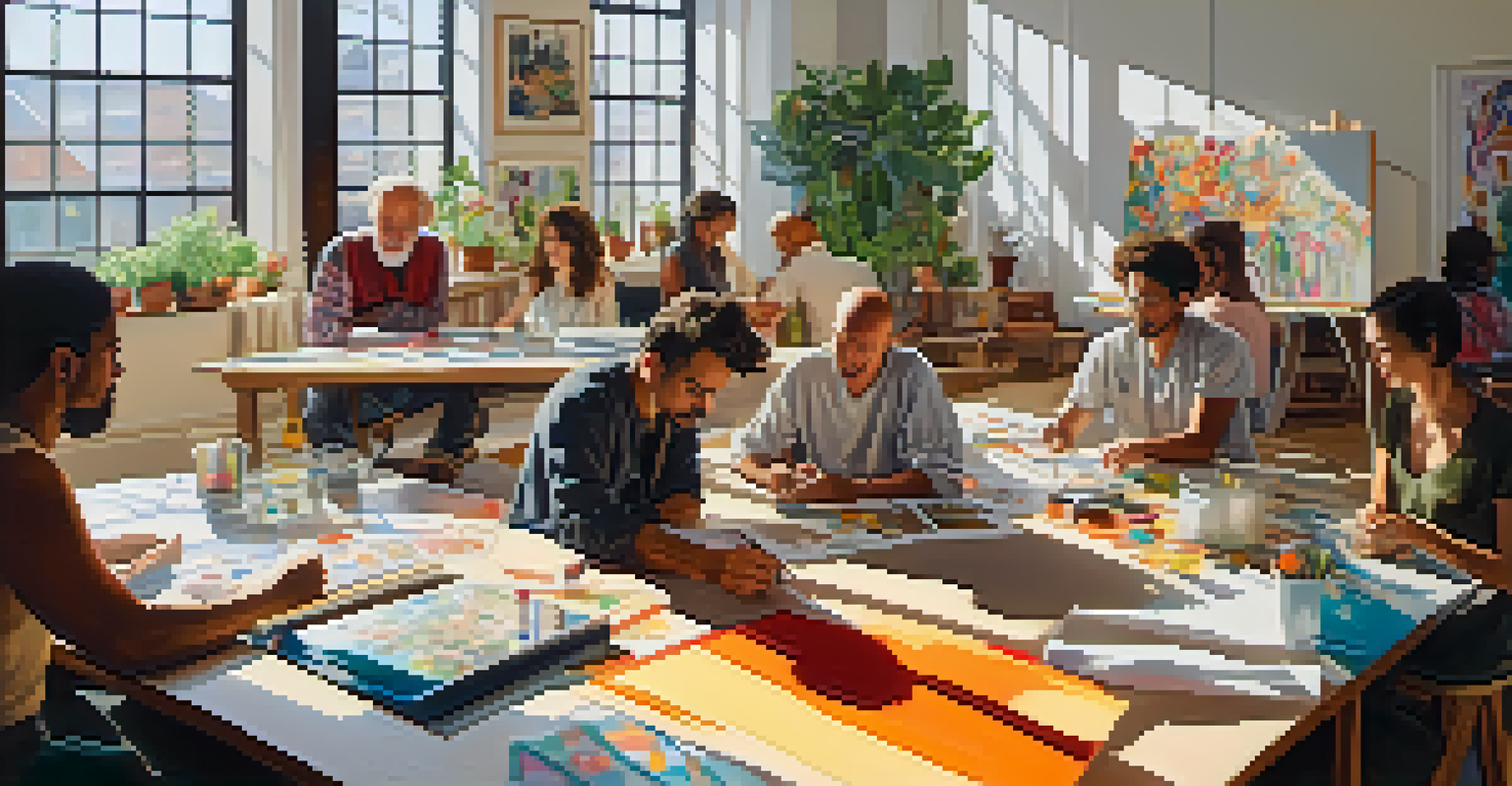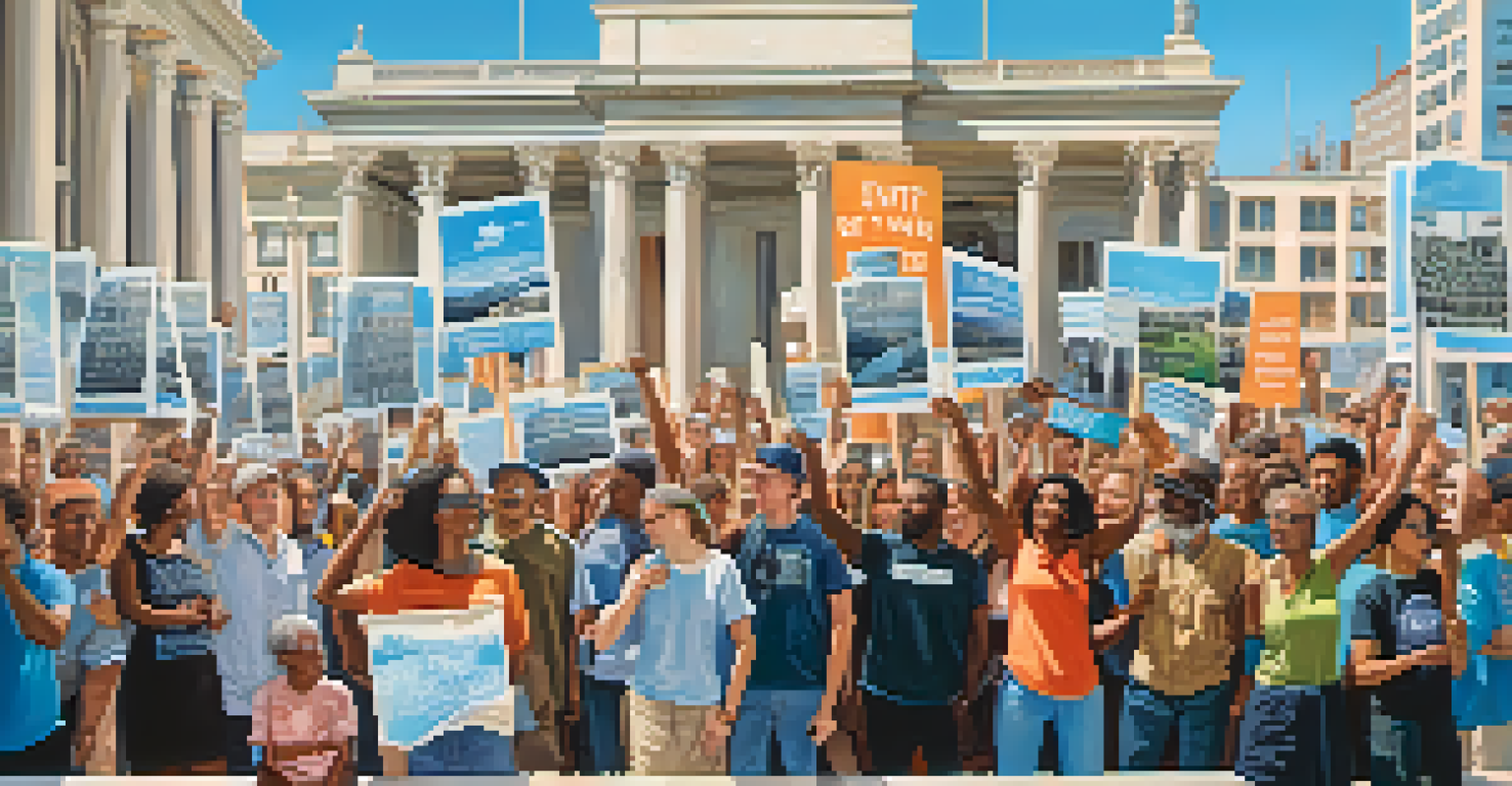Art and Global Citizenship: The Role of Artists in Society

Understanding Global Citizenship Through Art
Global citizenship is about recognizing our shared humanity and interconnectedness. Art serves as a powerful medium that transcends borders, allowing individuals to express their cultural identities while fostering empathy and understanding. Through various forms of artistic expression, people can reflect on societal issues that affect us all, regardless of where we live.
Art is a way of survival.
By engaging with art, we can explore themes like justice, equality, and human rights, making the abstract notion of global citizenship more tangible. For instance, street art often comments on local and global issues, prompting conversations that might not happen elsewhere. These artistic dialogues can inspire collective action and a sense of responsibility towards one another.
Ultimately, art holds the potential to unite diverse communities, creating a sense of belonging that is essential for a global citizen. It invites us to see the world through different lenses, encouraging us to act in ways that uplift not just ourselves, but our global neighbors as well.
The Artist as a Social Commentator
Artists have long been at the forefront of social change, using their talents to comment on pressing issues. From the poignant paintings of Diego Rivera to modern-day filmmakers tackling climate change, art can spotlight injustices and provoke thought. These works encourage viewers to reconsider their perspectives and engage in conversations that matter.

Take the example of music; songs like Bob Dylan's 'The Times They Are A-Changin'' became anthems for social movements, illustrating how artists can amplify voices and inspire action. By weaving narratives that resonate emotionally, artists can foster a deeper understanding of societal challenges, bridging gaps between cultures and communities.
Art Fosters Global Understanding
Through artistic expression, individuals can connect with diverse cultures and reflect on shared global issues.
In this way, artists serve not just as creators, but as catalysts for change. Their work can ignite passion and motivate individuals to take a stand, showing that art is not just about aesthetic appreciation but also about social responsibility.
Cultural Exchange and Collaboration in Art
Art is a language of its own, capable of fostering cross-cultural exchange. When artists from different backgrounds collaborate, they create works that reflect a blend of perspectives, enriching the narrative. This collaborative spirit not only enhances artistic expression but also promotes understanding and respect among diverse communities.
The artist is not a special kind of person; rather, each person is a special kind of artist.
For instance, international art projects often bring together artists to address global themes like migration or climate change. These projects can create a shared space for dialogue, allowing participants to learn from one another's experiences. This cultural exchange can break down barriers and foster solidarity, making the world feel a little smaller.
Such collaborations show that art is not confined by geography; it can connect people across oceans. By embracing this spirit of collaboration, artists contribute to a deeper sense of global citizenship, demonstrating that we can learn from one another and create a more inclusive society.
Art as a Tool for Advocacy and Activism
Art has the unique ability to advocate for change, often serving as a rallying cry for social movements. Through visual art, performances, and literature, artists can convey messages that resonate on an emotional level, urging audiences to act. This form of activism empowers individuals to join causes that promote justice and equality.
For example, the rise of digital art has allowed for rapid dissemination of messages, mobilizing communities around issues like racial justice and environmental sustainability. Artists leverage social media platforms to amplify their voices, making it easier for their work to reach a global audience. This dynamic exchange can inspire collective action, showing that art can be a powerful weapon in the fight for change.
Artists Drive Social Change
By commenting on societal challenges, artists inspire conversations and collective action towards justice and equality.
Ultimately, when artists harness their creativity for advocacy, they remind us that we all have a role to play in shaping society. Their contributions not only highlight urgent issues but also encourage us to take action, fostering a sense of agency in the pursuit of a better world.
The Impact of Art on Global Awareness
Art can illuminate global issues in ways that statistics and reports often cannot. By capturing the human experience, artists can evoke empathy and prompt viewers to reflect on their roles in the larger world. This emotional connection fosters a deeper understanding of the complexities surrounding topics like poverty, war, and climate change.
Consider the power of documentary photography; images from conflict zones can convey the harsh realities faced by individuals, stirring a sense of urgency in viewers. These visual narratives make distant struggles feel immediate and personal. By engaging with such art, audiences can become more informed and compassionate global citizens.
Through this lens, art becomes a tool for education, encouraging us to engage with and advocate for those affected by global challenges. As we become more aware, we are better equipped to support initiatives that promote positive change.
Art and Identity in a Global Context
Art often reflects cultural identity, providing a platform for marginalized voices. In a globalized world, artists can explore their heritage while also addressing universal themes, creating a rich tapestry of narratives that resonate with diverse audiences. This exploration of identity fosters a greater appreciation for cultural differences, promoting inclusivity.
For instance, indigenous artists often use traditional techniques to tell modern stories, bridging past and present. By sharing their unique experiences, they contribute to the global conversation about identity and belonging. This not only preserves cultural heritage but also encourages others to reflect on their own identities within a global context.
Collaboration Enhances Cultural Dialogue
Collaborative art projects break down barriers, promoting solidarity and a sense of belonging among diverse communities.
In this way, art becomes a space for dialogue around identity, allowing individuals to connect with their roots while also engaging with others. As we celebrate these diverse expressions, we reinforce the idea that everyone’s story matters in the tapestry of global citizenship.
The Future of Art in Global Citizenship
As we look to the future, the role of art in promoting global citizenship is more crucial than ever. With increasing global challenges, artists have the power to inspire hope and action through their work. By addressing contemporary issues, they can engage audiences in meaningful discussions about the world we want to create.
Emerging technologies, such as virtual reality and interactive installations, offer new ways for artists to connect with audiences on a global scale. These innovative approaches can enhance empathy and understanding, making complex issues more relatable. Artists who embrace these tools will continue to pave the way for global engagement and awareness.

Ultimately, the future of art lies in its ability to adapt and evolve in response to societal needs. By remaining committed to fostering dialogue and action, artists will play a pivotal role in shaping a more inclusive, compassionate world.